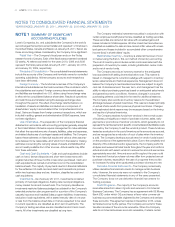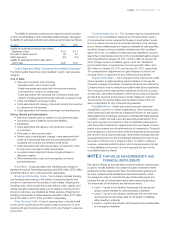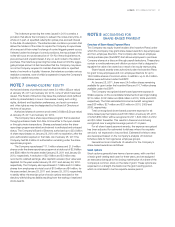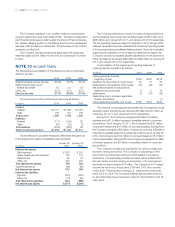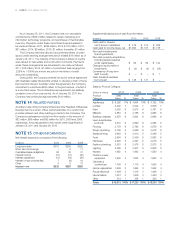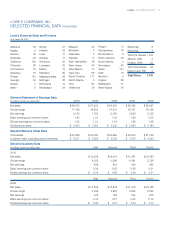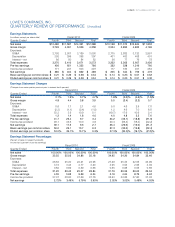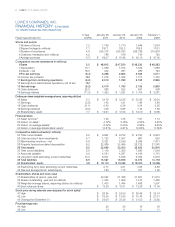Lowe's 2010 Annual Report Download - page 46
Download and view the complete annual report
Please find page 46 of the 2010 Lowe's annual report below. You can navigate through the pages in the report by either clicking on the pages listed below, or by using the keyword search tool below to find specific information within the annual report.
42 LOWE’S 2010 ANNUAL REPORT
The fair value of each option grant is estimated on the date of
grant using the Black-Scholes option-pricing model. When determining
expectedvolatility,theCompanyconsidersthehistoricalperformance
of the Company’s stock, as well as implied volatility. The risk-free interest
rate is based on the U.S. Treasury yield curve in effect at the time of
grant,basedontheoptions’expectedterm.Theexpectedtermof
the options is based on the Company’s evaluation of option holders’
exercisepatternsandrepresentstheperiodoftimethatoptionsare
expectedtoremainunexercised.TheCompanyuseshistoricaldatato
estimate the timing and amount of forfeitures. The assumptions used in
the Black-Scholes option-pricing model for options granted in 2010, 2009
and 2008 are as follows:
2010 2009 2008
Assumptions used:
Expectedvolatility 37.7%-41.4% 36.4%-38.6% 25.0%-32.2%
Weighted-average
expectedvolatility 39.4% 36.4% 25.1%
Expecteddividend
yield 0.96%-1.30% 0.82%-0.97% 0.56%-0.74%
Weighted-average
dividend yield 1.07% 0.82% 0.56%
Risk-free interest rate 1.22%-2.30% 1.70%-2.08% 2.19%-3.09%
Weighted-average
risk-free interest rate 2.02% 1.71% 2.19%
Expectedterm,inyears 4-5 4 4
Weighted-average
expectedterm,inyears 4.42 4 4
The weighted-average grant-date fair value per share of options
grantedwas$7.68,$4.58and$5.25in2010,2009and2008,respectively.
Thetotalintrinsicvalueofoptionsexercised,representingthedifference
betweentheexercisepriceandthemarketpriceonthedateofexercise,
wasapproximately$6million,$8millionand$17millionin2010,2009
and 2008, respectively.
Transactions related to stock options issued for the year ended
January 28, 2011 are summarized as follows:
Weighted-
Weighted- Average Aggregate
Average Remaining Intrinsic
Shares ExercisePrice Term Value
(In thousands) Per Share (In years) (In thousands)
1
Outstanding at
January29,2010 23,170 $26.42
Granted 3,208 23.96
Canceled, forfeited
orexpired (883) 26.74
Exercised (1,386) 19.31
Outstanding at
January28,2011 24,109 $26.48 3.06 $49,035
Vested and
expectedtovestat
January 28, 20112 23,473 $26.56 2.98 $48,083
Exercisableat
January28,2011 16,750 $29.13 2.04 $13,851
1 Options for which the exercise price exceeded the closing market price of a share of the Company’s common stock
at January 28, 2011 are excluded from the calculation of aggregate intrinsic value.
2 Includes outstanding vested options as well as outstanding, nonvested options after a forfeiture rate is applied.
Performance Accelerated Restricted Stock Awards (PARS)
PARS are valued at the market price of a share of the Company’s
common stock on the date of grant. In general, these awards vest
at the end of a five-year service period from the date of grant, unless
performance acceleration goals are achieved, in which case, awards
vest 50% at the end of three years or 100% at the end of four years.
The performance acceleration goals are based on targeted Company
average return on beginning non-cash assets, as defined in the PARS
agreement.PARSareexpensedonastraight-linebasisovertheshorter
oftheexplicitserviceperiodrelatedtotheserviceconditionorthe
implicit service period related to the performance conditions, based on
the probability of meeting the conditions. The Company uses historical
data to estimate the timing and amount of forfeitures. No PARS were
granted in 2010, 2009 or 2008. The total fair value of PARS vested
wasapproximately$7millionin2010and$6millionin2008.NoPARS
vested in 2009.
Transactions related to PARS issued for the year ended January 28,
2011 are summarized as follows:
Weighted-Average
Shares Grant-Date Fair
(In thousands) Value Per Share
NonvestedatJanuary29,2010 1,073 $32.91
Vested (311) 30.00
Canceled or forfeited (29) 33.59
NonvestedatJanuary28,2011 733 $34.11
Performance-Based Restricted Stock Awards
Performance-based restricted stock awards are valued at the market
price of a share of the Company’s common stock on the date of grant.
In general, 25% to 100% of the awards vest at the end of a three-year
service period from the date of grant based upon the achievement of
a threshold and target performance goal specified in the performance-
based restricted stock agreement. The performance goal is based on
targeted Company average return on non-cash assets, as defined in
the performance-based restricted stock agreement. These awards
areexpensedonastraight-linebasisovertherequisiteserviceperiod,
based on the probability of achieving the performance goal. If the
performance goal is not met, no compensation cost is recognized
and any previously recognized compensation cost is reversed. The
Company uses historical data to estimate the timing and amount of
forfeitures. The weighted-average grant-date fair value per share of
performance-basedrestrictedstockawardsgrantedwas$23.97in
2008. No performance-based restricted stock awards were granted
in 2010 or 2009. The total fair value of performance-based restricted
stockawardsvestedwasapproximately$4millionin2010.No
performance-based restricted stock awards vested in 2009 or 2008.
During 2008, the Company amended all 2007 performance-based
restricted stock agreements, modifying the performance goal to a
prorated scale, which caused the probability of vesting to go from
improbable to probable.




